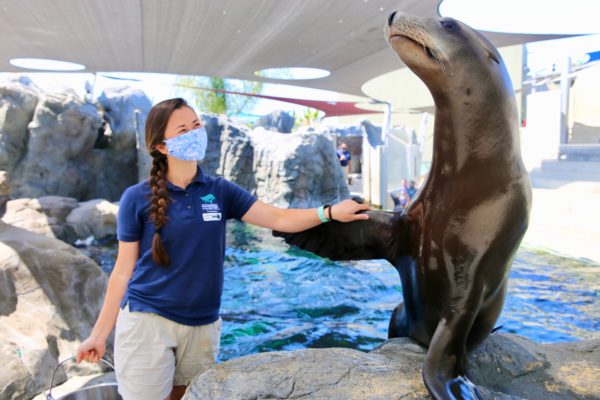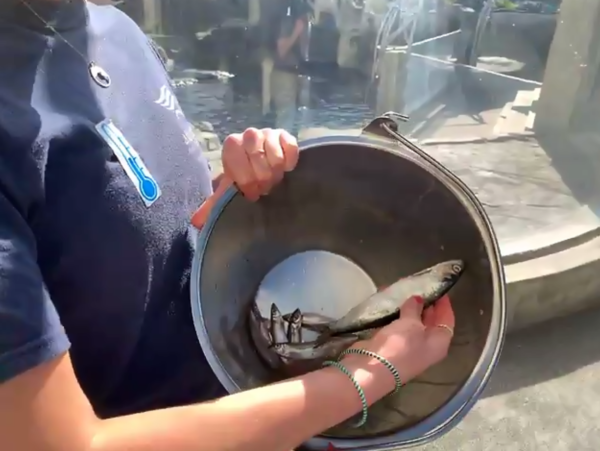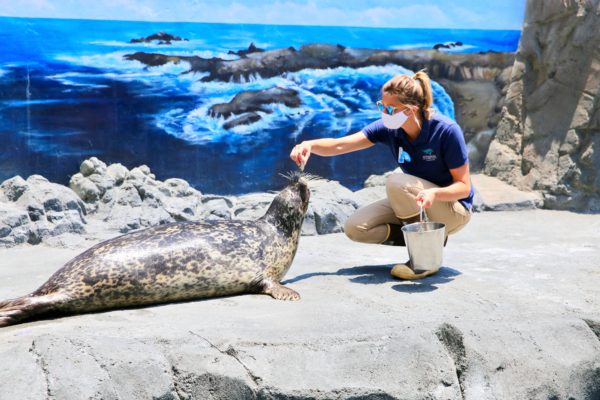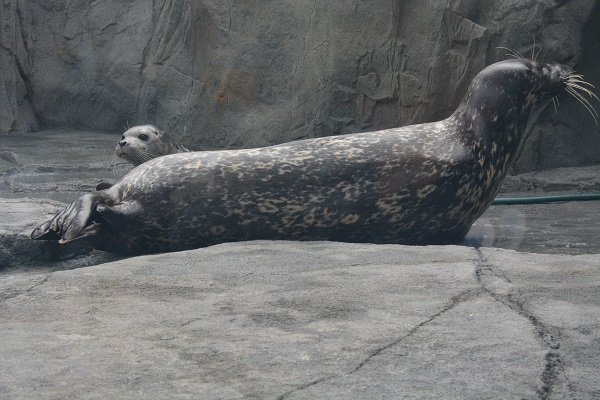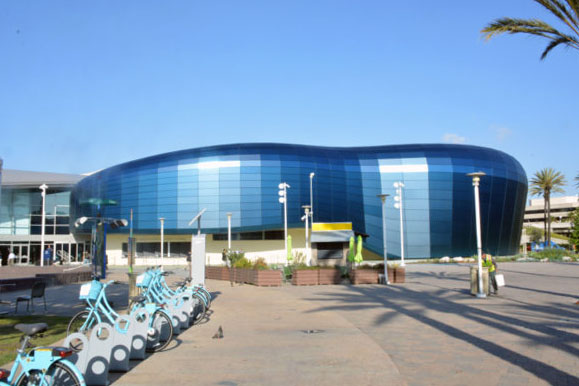by Noella Noelophile®
How do you prevent a sea lion from playing with his food?
If you invited a seal and a sea lion to a party, which one would be more likely to have fun?
And how would you tell the difference between the two, anyway?
Those were just three of the questions which mammalogist Sarah Larsen answered, during Saturday morning’s “Virtual Seal and Sea Lion Encounter”, hosted by Long Beach’s Aquarium of the Pacific.
Since the pandemic forced the Aquarium’s temporary closure, they’ve introduced multiple virtual offerings. Among them: “Virtual Animal Encounters”, which allow visitors to spend thirty minutes, virtually, with either an otter or a sea lion and the animal’s trainer. During that time, guests learn more about the animals’ habits and daily lives.
Meet “Harpo”
 Saturday’s Zoom session starred “Harpo”, a 13-year-old California sea lion.
Saturday’s Zoom session starred “Harpo”, a 13-year-old California sea lion.
Harpo and Sarah demonstrated the ways the Aquarium trains sea lions, in their daily activities, to perform certain behaviors.
That included good “table manners”.
“(If) he slips the fish, I’m not going to reinforce him…I’m just going to stand still for a minute,” Sarah said.
“This is what we call an LRS, or a least-reinforcing scenario.”
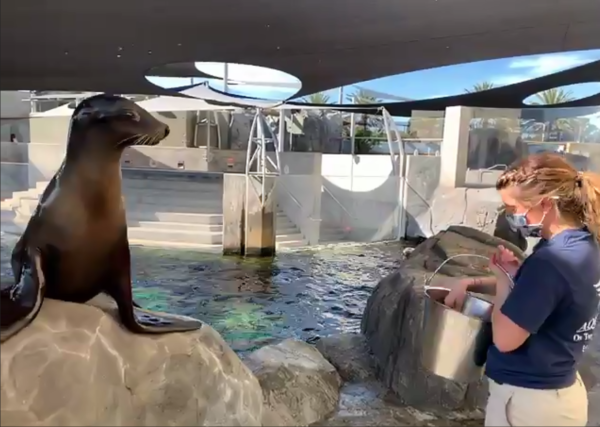 Sarah explained that she wasn’t “punishing” Harpo. Instead, an LRS involves ignoring certain behaviors that Aquarium staff wants to minimize. When Harpo takes his food well, without playing, he gets rewarded with treats and attention.
Sarah explained that she wasn’t “punishing” Harpo. Instead, an LRS involves ignoring certain behaviors that Aquarium staff wants to minimize. When Harpo takes his food well, without playing, he gets rewarded with treats and attention.
Sarah also took Harpo through other behaviors he’s been taught. At her direction, he stretched out flat on a rock–which enables Aquarium staff to do a voluntary blood draw from his rear flippers. His reward, for doing so calmly, is always positive reinforcement.
“I give him lots of food, letting him know that’s exactly what he needs to do,” Sarah said. “He did an awesome job.”
Now–what kind of food? Well, herring, mostly.
“(Herring) is one of the main foods, it’s kind of like the meat and potatoes, of (sea lions’) diet,” Sarah said, in response to a question. Harpo, she said, eats around ten pounds of food a day.
“In general, our largest California sea lion eats around 16 kilos (of restaurant-quality seafood daily)–about 33 or 34 pounds.”
Deep-sea dentistry
Other husbandry behaviors which Harpo and his fellow seals and sea lions are taught, Sarah continued, include opening their mouths on command so the staff can check their teeth.
Harpo’s teeth are brown–but that doesn’t mean he needs a toothbrush.
“They’re supposed to be brown, because they excrete a natural oil that coats the teeth, makes it healthy for them,” Sarah explained.
“(But) harbor seals have nice white teeth, that we actually brush every single day.”
Physical and mental fitness, sea lion-style
Monitoring the animals’ physical health is another goal of the behavioral training.
“We train them so that they can constantly participate in behaviors,” Sarah said.
“…If I see Harpo one day, as maybe not really participating or not as high-energy, it can sometimes be a cue to me that something’s wrong. Maybe he’s not feeling well or maybe he has an injury on the flipper, something like that.”
And, of course, keeping Harpo and his fellow Aquarium denizens mentally engaged and interested, is another objective.
“I like to keep my brain stimulated. We want to make sure that we keep his brain stimulated,” Sarah continued.
“We’re always working on new behaviors.”
During this portion of the program, Harpo showcased his skills in mimicry.
Following Sarah’s lead, he jumped up and down.
“When I do a spin, he’ll do a spin too,” Sarah said. And he did!
Then, he lay down and allowed her to pretend to tickle his belly.
Now, how long did it take Harpo to learn to do all this?
“We kind of say training never ends,” Sarah said.
“…That tickle behavior only took us a few weeks, one or two sessions a day. for maybe three or four weeks. (But) something like the voluntary blood draw (where Harpo lay calmly on the rock) can take years and years and years to train.”
In addition, she explained, sea lions are like people. Needles can be a little scary for them, And over time, they can forget what they’ve learned.
“Animals tend to veer away, just like us,” Sarah explained. “…Maybe you forget (concepts) and need to revisit (them).”
Seal versus sea lion
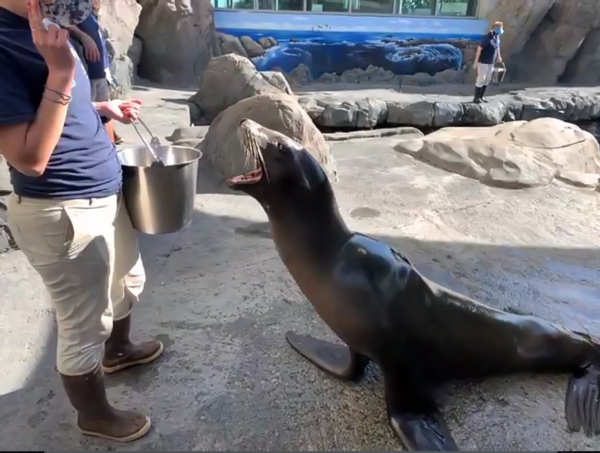 Next, with help from Harpo, Sarah demonstrated some of the differences between a seal and a sea lion.
Next, with help from Harpo, Sarah demonstrated some of the differences between a seal and a sea lion.
First, Harpo imitated a seal’s motion.
“This is how a seal moves. They do a scoot, they use those belly muscles. So Harpo is kind of mimicking a seal here, ” Sarah explained. (Sea lions, on the other hand–or flipper–put their full body weight on their strong front flippers, using them to propel themselves on land, and to swim.)
Other differences, Sarah continued, include that sea lions are very vocal, compared to harbor seals. Harpo illustrated, by offering a vocal!
Meanwhile, there’s the coloration difference. Sea lions are a dark chocolate color, while harbor seals are spotted.
And, Sarah said, sea lions are more social, liking to congregate in big groups. Harbor seals tend to be more solitary. (So if both a seal and a sea lion could attend a party, the seal might sit quietly in a corner, while the sea lion worked the room!)
But the most noticeable difference?
“Looking at their ears is one of the best ways to tell seals and sea lions apart,” Sarah said.
“Seals don’t have external ear flaps. There’s this little hole, they still can hear just as well, but they don’t have that external (ear) where sea lions do.”
One virtual guest asked Sarah, “What is your favorite part of working with the sea lions?”
“I think they’re just so goofy,” she said. “They’re just a lot of fun. …And I actually love diving with them. We do clean our exhibits every week, so we actually get to (dive) with them…They’re beautiful above water, but underwater they’re really majestic.
…”They’re funny, the things they come up with, the way they interact. They’re just fun animals.”

